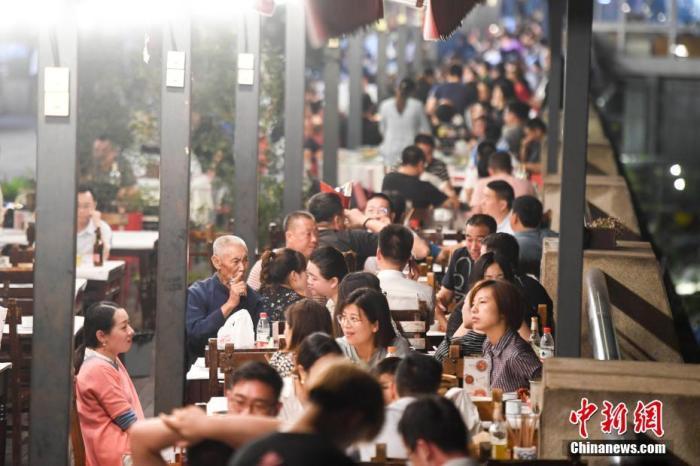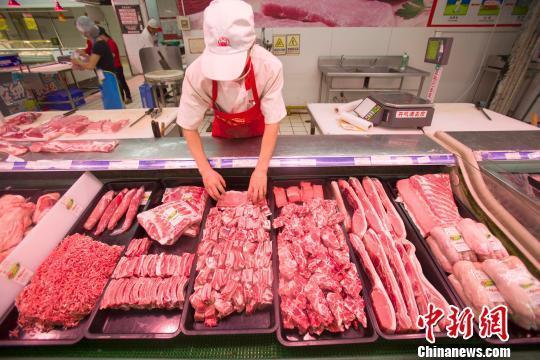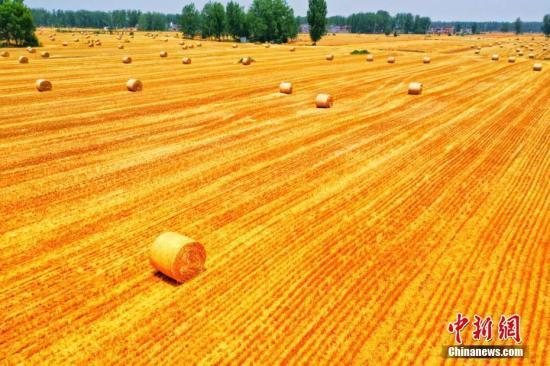Beijing, August 14th (Reporter Li Jinlei) On August 14th, the National Bureau of Statistics released the economic data of China in July. How did China’s economy start in the second half of the year? Is the price of pork still rising? Is there enough food stock?
Let’s look at the performance of the "troika" of consumption, export and investment.

Changsha’s "night economy" has gradually recovered. Citizens travel and taste delicious food on summer nights. Photo by Yang Huafeng
The growth rate of commodity retail sales changed from negative to positive for the first time in the year.
With the return of fireworks, "buy buy Buy" is also speeding up.
According to the data released by the National Bureau of Statistics, the market sales continued to pick up in July, with retail sales of 2,892 billion yuan, the growth rate turned from negative to positive for the first time in the year, with an increase of 0.2%.
Online retailing continues to improve. From January to July, the national online retail sales reached 6,078.5 billion yuan, up 9.0% year-on-year, 1.7 percentage points faster than that in January-June.
Export growth rate reached double digits.
Data show that in July, the total import and export volume of goods was 2,927 billion yuan, up 6.5% year-on-year. Among them, exports were 1,684.6 billion yuan, an increase of 10.4%; Imports reached 1,242.4 billion yuan, up by 1.6%.
The export growth rate in July not only set a record since the outbreak of the epidemic, but also was much higher than other major economies in the world, and it was also the highest since March last year.
Fu Linghui, spokesperson of the National Bureau of Statistics, analyzed that foreign trade was better than expected in July, and exports achieved positive growth for four consecutive months, because China’s economic resilience and potential were huge, and its adjustment and adaptability were relatively strong. A series of policies to support foreign trade stability would play a positive role in stabilizing and expanding exports of foreign trade enterprises. Moreover, China has a complete industrial system, strong supporting capacity, strong ability to adjust and adapt to external changes, and the export of anti-epidemic materials plays a pulling role.

The picture shows Haikou xiuying port Container Terminal. Luo Yunfei
The decline in investment continued to narrow.
The data shows that from January to July, the national investment in fixed assets (excluding farmers) was 32,921.4 billion yuan, down 1.6% year-on-year, and the decline rate was 1.5 percentage points narrower than that in January-June; In July, the chain increased by 4.85%.
Let’s look at the performance of two livelihood indicators: price and employment.
Pork prices rose by 85.7%
In July, the national consumer price rose by 2.7% year-on-year, an increase of 0.2 percentage points over that in June.
Among the food, tobacco and alcohol prices, pork rose by 85.7%, fresh vegetables by 7.9%, grain by 1.6% and fresh fruit by 27.7%.

Data map: Supermarket employees are sorting out pork. Photo by Zhang Yun
It can be seen that the price increase of "Second Brother" is still high.
The price of pork once fell back, why did it rebound again? Fu Linghui said that pork prices have risen. First, with the resumption of production, catering services have gradually recovered and pork demand has expanded; Second, the flood in the south in July had some adverse effects on pig production and transportation.
Regarding the trend of pork prices, Fu Linghui said that from the survey, the number of live pigs is increasing quarter by quarter, but from the supply situation, the production and supply of live pigs are still in a tight balance, and the high price will last for some time. Generally speaking, it is unlikely that pork prices will rise sharply.
Grain stocks are relatively sufficient.
Regarding the grain price that everyone cares about, Fu Linghui said that China’s grain production has been stable at more than 1.3 trillion Jin for five consecutive years, and at present, the grain stock is relatively sufficient. This year’s summer grain harvest has also reached a record high, and the output of summer grain has increased by 0.9% over the previous year.
Fu Linghui said that overall, agricultural investment has gradually increased in recent years, and there is still a good foundation for food stability. It is basic and conditional for food prices to remain stable throughout the year.

Data map: In the wheat harvest season, the wheat waves are rolling everywhere. Photo by Liu Hao Chen Jie
The employment situation is generally stable.
Employment is the foundation of people’s livelihood. Data show that from January to July, 6.71 million new jobs were created in cities and towns nationwide, an increase of 1.96 million less than that in the same period of last year.
In July, the national urban survey unemployment rate was 5.7%, the same as in June; Among them, the unemployment rate of the population aged 25-59 was 5.0%, down by 0.2 percentage points; However, the unemployment rate in the youth population survey has increased.
Fu Linghui reminded that the number of college graduates reached 8.74 million this year, a record high. In July, with the concentration of college students entering the labor market, they are 20 years old — The unemployment rate of people aged 24 and above (mainly newly graduated college students) is rising, which is 3.3 percentage points higher than that of the same period last year. We should attach great importance to the pressure of these key groups.
Zhang Jinan, Minister of Human Resources and Social Security, recently pointed out that in the second half of the year, college graduates will continue to be encouraged to expand the scale of enterprise absorption, expand the scale of grassroots employment, expand the scale of further studies, and expand the scale of training and internship. (End)